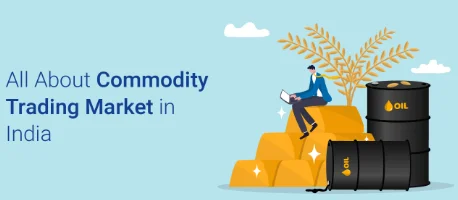
Introduction
Welcome to our comprehensive commodity market guide, where we delve into the complexities of this dynamic and lucrative sector. We are committed, as industry experts, to providing you with valuable insights and detailed information that will help you gain a competitive edge in the commodity trading landscape.
What exactly is the Commodity Market?
The commodity market is a marketplace for the purchase and sale of various raw materials or primary agricultural products. Precious metals, energy resources, agricultural products, and other items are examples of commodities. Commodity traders and investors use commodity trading to profit from price fluctuations, hedge against risks, and diversify their investment portfolios.
Types of Commodities
1. Agricultural Commodities
Crops, livestock, and other related products are examples of agricultural commodities. Grains (such as wheat, corn, and soybeans), livestock (such as cattle and hogs), and soft commodities (such as coffee, cocoa, and cotton) fall into this category. Weather, government policies, and global demand all have a significant impact on agricultural commodity prices.
2. Energy Commodities
Energy commodities include all resources used to generate energy. Energy commodities include crude oil, natural gas, coal, and electricity. Geopolitical factors, production levels, technological advancements, and environmental regulations all have an impact on energy markets. Understanding these influences is critical for profitable trading in this industry.
3. Metals Commodities
Precious metals such as gold, silver, and platinum, as well as industrial metals such as copper, aluminum, and steel, are examples of metal commodities. These commodities play critical roles in a variety of industries and are influenced by supply and demand dynamics, geopolitical tensions, economic indicators, and global infrastructure development.
4. Other Commodities
Aside from agricultural, energy, and metals commodities, the market trades a variety of other commodities. Among these are, but are not limited to:
- Soft commodities include products such as sugar, coffee, cotton, and cocoa.
- Livestock and meat: Products traded include lean hogs, pork bellies, and live cattle.
- Precious stones: These include diamonds, rubies, emeralds, and other gemstones.
- Chemicals: This sector includes industrial chemicals such as fertilizers, plastics, and solvents.
- Timber: Wood and timber products are also traded commodities.
Understanding Commodity Trading
1. Spot Market vs. Futures Market
In commodity trading, there are two primary types of markets: spot market and futures market.
- Spot Market: Commodities are bought and sold on the spot market for immediate delivery. Spot market prices are influenced by supply and demand, as well as other market conditions.
- Futures Market: The futures market is where commodity contracts for future delivery are traded. These contracts specify the commodity’s quantity, quality, and delivery date. Futures markets offer opportunities for price hedging and speculation.
2. Key Participants in Commodity Trading
Several key participants contribute to the functioning of the commodity market. These participants include:
- Producers: Individuals or businesses involved in the production and extraction of commodities are referred to as producers.
- Consumers: Consumers are entities who need commodities for consumption or further processing.
- Traders: People or businesses who buy and sell commodities in order to profit from price fluctuations.
- Speculators: Market participants who seek to profit from price changes but do not intend to own the commodities.
- Commodity Exchanges: Marketplaces for traders and investors to trade standardized commodity contracts.
3. Factors Affecting Commodity Prices
A variety of factors influence commodity prices. Among the significant factors are:
- Supply and Demand: The supply-demand balance is critical in determining commodity prices.
- Economic Indicators: Commodity prices are influenced by economic indicators such as GDP growth, inflation rates, and interest rates.
- Geopolitical Factors: Warfare, conflict, trade policies, and sanctions all have an impact on commodity markets.
- Weather Conditions: Natural disasters and seasonal variations have an impact on agricultural commodities.
- Currency Exchange Rates: Changes in exchange rates can have an impact on commodity prices, particularly for commodities traded internationally.
Benefits and Risks of Commodity Trading
Benefits
- Diversification: Commodities offer an opportunity to diversify investment portfolios beyond traditional asset classes such as stocks and bonds.
- Inflation Hedge: Historically, certain commodities, such as gold, have served as a hedge against inflation.
- Profit Opportunities: Price volatility in the commodity market provides opportunities for traders to profit.
- Risk Management: Commodity futures contracts can be used by producers and consumers to hedge against price risks.
Risks
- Price Volatility: Commodity prices can be volatile, resulting in potential losses.
- Market Complexity: Commodity markets are influenced by a variety of factors, making them difficult to analyze and predict.
- Regulatory Risks: Changes in government policies, regulations, or trade agreements can all have an impact on commodity markets.
- Operational Risks: Logistics, storage, and transportation issues can all have an impact on physical commodity trading.
Conclusion
Finally, the commodity market provides a wide variety of trading opportunities in agricultural, energy, metals, and other commodities. Understanding the nuances of this market is critical for traders and investors looking to capitalize on price movements while effectively managing risks. By utilizing our comprehensive guide, you are now equipped with the knowledge to confidently navigate the commodity market and make informed trading decisions.
FOR MORE INFO CLICK THIS SITE:https://learningsharks.in/
FOLLOW OUR PAGE:https://www.instagram.com/learningsharks/?hl=en
